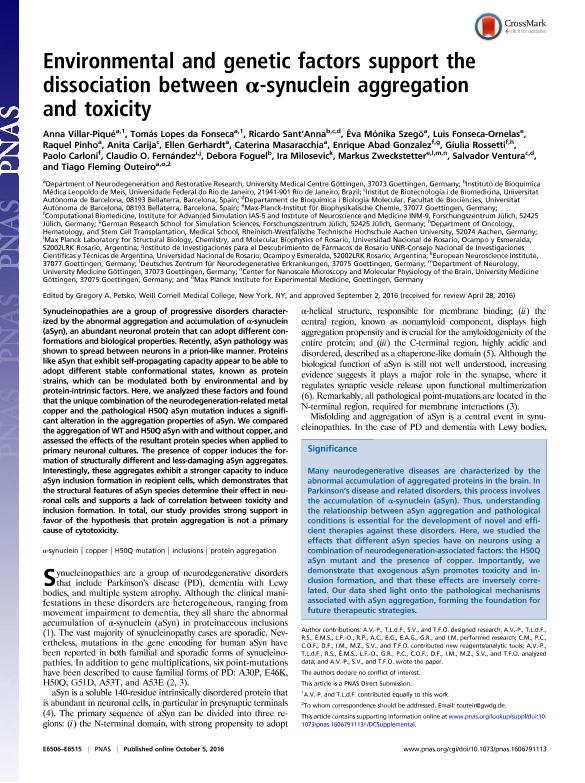Mostrar el registro sencillo del ítem
dc.contributor.author
Villar Piqué, Anna
dc.contributor.author
Da Fonseca, Tomás Lopes
dc.contributor.author
Sant'Anna, Ricardo
dc.contributor.author
Szegö, Éva Mónika
dc.contributor.author
Fonseca Ornelas, Luis
dc.contributor.author
Pinho, Raquel
dc.contributor.author
Carija, Anita
dc.contributor.author
Gerhardt, Ellen
dc.contributor.author
Masaracchia, Caterina
dc.contributor.author
Gonzalez, Enrique Abad
dc.contributor.author
Rossetti, Giulia
dc.contributor.author
Carloni, Paolo
dc.contributor.author
Fernandez, Claudio Oscar

dc.contributor.author
Foguel, Debora
dc.contributor.author
Milosevic, Ira
dc.contributor.author
Zweckstetter, Markus
dc.contributor.author
Ventura, Salvador
dc.contributor.author
Outeiro, Tiago Fleming
dc.date.available
2020-08-10T20:38:24Z
dc.date.issued
2016-10
dc.identifier.citation
Villar Piqué, Anna; Da Fonseca, Tomás Lopes; Sant'Anna, Ricardo; Szegö, Éva Mónika; Fonseca Ornelas, Luis; et al.; Environmental and genetic factors support the dissociation between α-synuclein aggregation and toxicity; National Academy of Sciences; Proceedings of the National Academy of Sciences of The United States of America; 113; 42; 10-2016; 6506-6515
dc.identifier.issn
0027-8424
dc.identifier.uri
http://hdl.handle.net/11336/111370
dc.description.abstract
Synucleinopathies are a group of progressive disorders characterized by the abnormal aggregation and accumulation of α-synuclein (aSyn), an abundant neuronal protein that can adopt different conformations and biological properties. Recently, aSyn pathology was shown to spread between neurons in a prion-like manner. Proteins like aSyn that exhibit self-propagating capacity appear to be able to adopt different stable conformational states, known as protein strains, which can be modulated both by environmental and by protein-intrinsic factors. Here, we analyzed these factors and found that the unique combination of the neurodegeneration-related metal copper and the pathological H50Q aSyn mutation induces a significant alteration in the aggregation properties of aSyn. We compared the aggregation of WT and H50Q aSyn with and without copper, and assessed the effects of the resultant protein species when applied to primary neuronal cultures. The presence of copper induces the formation of structurally different and less-damaging aSyn aggregates. Interestingly, these aggregates exhibit a stronger capacity to induce aSyn inclusion formation in recipient cells, which demonstrates that the structural features of aSyn species determine their effect in neuronal cells and supports a lack of correlation between toxicity and inclusion formation. In total, our study provides strong support in favor of the hypothesis that protein aggregation is not a primary cause of cytotoxicity.
dc.format
application/pdf
dc.language.iso
eng
dc.publisher
National Academy of Sciences

dc.rights
info:eu-repo/semantics/openAccess
dc.rights.uri
https://creativecommons.org/licenses/by-nc-nd/2.5/ar/
dc.subject
COPPER
dc.subject
PROTEIN AGGREGATION
dc.subject
INCLUSIONS
dc.subject
α-SYNUCLEIN
dc.subject
H50Q MUTATION
dc.subject.classification
Otras Ciencias Biológicas

dc.subject.classification
Ciencias Biológicas

dc.subject.classification
CIENCIAS NATURALES Y EXACTAS

dc.title
Environmental and genetic factors support the dissociation between α-synuclein aggregation and toxicity
dc.type
info:eu-repo/semantics/article
dc.type
info:ar-repo/semantics/artículo
dc.type
info:eu-repo/semantics/publishedVersion
dc.date.updated
2018-07-18T20:47:08Z
dc.identifier.eissn
1091-6490
dc.journal.volume
113
dc.journal.number
42
dc.journal.pagination
6506-6515
dc.journal.pais
Estados Unidos

dc.journal.ciudad
Washington
dc.description.fil
Fil: Villar Piqué, Anna. Universität Göttingen; Alemania
dc.description.fil
Fil: Da Fonseca, Tomás Lopes. Universität Göttingen; Alemania
dc.description.fil
Fil: Sant'Anna, Ricardo. Universidade Federal do Rio de Janeiro; Brasil. Universitat Autònoma de Barcelona; España
dc.description.fil
Fil: Szegö, Éva Mónika. Universität Göttingen; Alemania
dc.description.fil
Fil: Fonseca Ornelas, Luis. Max-Planck-Institut für Biophysikalische Chemie; Alemania
dc.description.fil
Fil: Pinho, Raquel. Universität Göttingen; Alemania
dc.description.fil
Fil: Carija, Anita. Universitat Autònoma de Barcelona; España
dc.description.fil
Fil: Gerhardt, Ellen. Universität Göttingen; Alemania
dc.description.fil
Fil: Masaracchia, Caterina. Universität Göttingen; Alemania
dc.description.fil
Fil: Gonzalez, Enrique Abad. Helmholtz Gemeinschaft. Forschungszentrum Jülich; Alemania. Rwth Aachen University; Alemania
dc.description.fil
Fil: Rossetti, Giulia. Helmholtz Gemeinschaft. Forschungszentrum Jülich; Alemania. Aachen University; Alemania
dc.description.fil
Fil: Carloni, Paolo. Helmholtz Gemeinschaft. Forschungszentrum Jülich; Alemania
dc.description.fil
Fil: Fernandez, Claudio Oscar. Consejo Nacional de Investigaciones Científicas y Técnicas. Centro Científico Tecnológico Conicet - Rosario. Instituto de Investigaciones para el Descubrimiento de Fármacos de Rosario. Universidad Nacional de Rosario. Instituto de Investigaciones para el Descubrimiento de Fármacos de Rosario; Argentina. Universidad Nacional de Rosario; Argentina
dc.description.fil
Fil: Foguel, Debora. Universidade Federal do Rio de Janeiro; Brasil
dc.description.fil
Fil: Milosevic, Ira. European Neuroscience Institut; Alemania
dc.description.fil
Fil: Zweckstetter, Markus. Universität Göttingen; Alemania. Helmholtz Gemeinschaft. Forschungszentrum Jülich; Alemania. Max Planck Institute for Biophysical Chemistry; Alemania. German Centre for Degenerative Diseases; Alemania
dc.description.fil
Fil: Ventura, Salvador. Universitat Autònoma de Barcelona; España
dc.description.fil
Fil: Outeiro, Tiago Fleming. Universität Göttingen; Alemania. Max Planck Institute for Experimental Medicine Göttingen; Alemania
dc.journal.title
Proceedings of the National Academy of Sciences of The United States of America

dc.relation.alternativeid
info:eu-repo/semantics/altIdentifier/doi/https://dx.doi.org/10.1073/pnas.1606791113
dc.relation.alternativeid
info:eu-repo/semantics/altIdentifier/url/http://www.pnas.org/content/113/42/E6506
Archivos asociados
